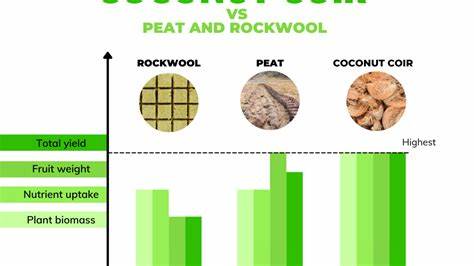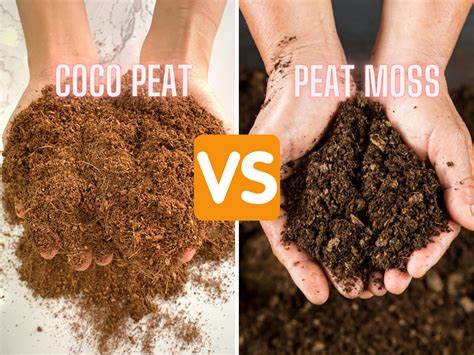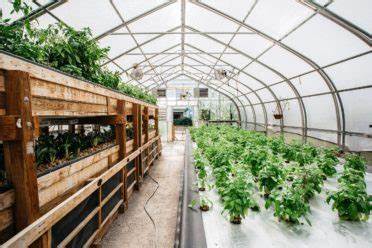
The Significance of Growing Media in Gardening and Horticulture
Introduction
Growing media selection is a critical factor in gardening and horticulture practices, directly influencing plant growth, nutrient uptake, and overall health. This article explores the three primary options for growing media: Coconut Coir, Rockwool, and Peat Moss. Each of these media offers unique characteristics and benefits, making them suitable for various applications in gardening and horticulture.
Historical Background
Coconut Coir, derived from the fibrous outer husk of coconuts, has been utilized in gardening for centuries. Its origins can be traced back to ancient Sri Lanka, where its effectiveness as a growing medium was first discovered. With exceptional water retention and durability, its usage spread globally over time.
Rockwool, also known as mineral wool or stone wool, was initially developed by Danish scientist Poul Varming in the early 20th century for thermal insulation purposes. Recognizing its potential as a growing medium in the 1960s, it gained popularity in greenhouse cultivation and hydroponics systems.
Peat Moss, a partially decomposed plant material found in peatlands, has a long history in gardening. Ancient civilizations employed it for its water retention properties and ability to improve soil structure, making it a trusted medium for centuries.
Key Concepts and Definitions
Coconut Coir, a natural byproduct of the coconut industry, is produced by processing the fibrous outer husk of coconuts. It offers excellent water retention, high porosity, and good aeration for root development. Additionally, Coconut Coir is lightweight, renewable, and environmentally friendly.
Rockwool, created from molten basalt rock and limestone, undergoes a process where it is spun into fibers and then compressed into cubes or slabs. It provides excellent water retention, good drainage, and high air porosity. Rockwool maintains a stable pH level, making it suitable for hydroponic and soilless cultivation systems.
Peat Moss, also known as sphagnum peat moss, is harvested from peat bogs. It consists of partially decomposed sphagnum moss and plant materials. Peat Moss possesses excellent water retention capabilities and enhances soil structure. It finds common usage in container gardening, seed starting, and soil conditioning.

Main Discussion Points
Composition and Structure
Coconut Coir primarily consists of lignin, cellulose, and hemicellulose. Its fibrous structure allows ample space for root growth and aeration. Coconut Coir possesses a neutral pH level and is free from pathogens or weed seeds.
Rockwool consists of fine fibers derived from molten basalt rock and limestone. These fibers create air pockets, enabling roots to access oxygen. With a slightly alkaline pH, Rockwool can be adjusted by soaking it in water with a lower pH.
Peat Moss is composed of partially decomposed sphagnum moss and plant matter. Its fibrous structure assists in moisture retention and provides a suitable environment for root development. Peat Moss has an acidic pH, which benefits acid-loving plants.
Water Retention and Drainage
Coconut Coir exhibits excellent water retention capabilities, allowing it to retain moisture for extended periods. Simultaneously, it provides adequate drainage, preventing waterlogging and root rot. Maintaining this balance is crucial for optimal plant growth and preventing overwatering.
Rockwool offers exceptional water retention and drainage properties. It can retain a significant amount of water while enabling excess water to drain away. This ensures a consistent moisture level and prevents waterlogging, facilitating healthy root development.
Peat Moss possesses exceptional water retention capabilities, effectively holding moisture. However, over time, it can become compacted, resulting in poor drainage. Proper aeration and mixing with other materials are necessary to maintain optimal moisture levels and prevent compaction.
Nutrient Retention and Availability
Coconut Coir has a high cation exchange capacity (CEC), allowing it to retain and release nutrients to plants. It acts as a sponge, holding essential nutrients and gradually releasing them as needed. This promotes healthy root development and nutrient uptake.
Rockwool has a low CEC but is an inert medium, devoid of nutrients. It relies on nutrient solutions or fertilizers to provide essential elements to plants. Nevertheless, its structure ensures efficient distribution of nutrients to the root zone.

Peat Moss possesses a moderate CEC, allowing it to absorb and retain nutrients, making them available to plants. However, it is important to note that Peat Moss has low nutrient content and may require supplementation with fertilizers for optimal plant growth.
Environmental Impact
Coconut Coir production has a relatively low environmental impact as it utilizes a byproduct of the coconut industry, preventing waste and utilizing a renewable resource. However, concerns have been raised about the carbon footprint associated with transportation, as Coir is often imported from tropical regions.
Rockwool production raises environmental considerations due to its energy-intensive processes and reliance on non-renewable resources. Additionally, the disposal of used Rockwool can be challenging, as it is not biodegradable and contributes to landfill waste.
Peat Moss extraction raises concerns due to its impact on peatland ecosystems. Peatlands are important carbon sinks and habitats for unique flora and fauna. The extraction of Peat Moss disrupts these ecosystems and contributes to carbon emissions. Sustainable alternatives and responsible harvesting practices are being explored to mitigate these concerns.
Case Studies or Examples
Coconut Coir has been successfully used in hydroponic systems. One case study involved cultivating lettuce using Coconut Coir as the growing medium, resulting in improved plant growth, increased yields, and reduced water consumption compared to traditional soil-based systems.
Rockwool has found widespread usage in commercial greenhouse operations. In one real-world example, a greenhouse grew tomatoes using Rockwool cubes. The controlled environment, combined with the excellent water retention and drainage properties of Rockwool, resulted in higher yields and healthier plants.
Peat Moss is commonly used in container gardening and seed starting. For instance, a home gardener used Peat Moss as a seed starting medium for various vegetable crops. Peat Moss provided optimal moisture retention and promoted successful germination and healthy seedling growth.
Current Trends or Developments
Coconut Coir utilization has seen recent advancements in research and practical applications. Studies are exploring its potential for sustainable agriculture, biodegradable packaging materials, and soil erosion control. Furthermore, innovations in Coir processing techniques are improving its quality and performance as a growing medium.
Rockwool technology continues to evolve, with new applications and innovations emerging. Research is focused on enhancing its water and nutrient distribution capabilities, as well as exploring its potential for vertical farming systems. Efforts are also being made to improve the environmental impact of Rockwool production and disposal.
Peat Moss alternatives and sustainable substitutes are gaining attention. Materials such as composted bark, coir pith, and biochar are being explored as potential replacements for Peat Moss. These alternatives offer similar water retention and drainage characteristics while reducing the environmental impact associated with Peat Moss extraction.
Challenges or Controversies
Coconut Coir can present challenges related to salinity and pH levels. The quality of Coir can vary, and excessive salt content or high pH levels can impact plant health. Proper sourcing of Coir from reputable suppliers and appropriate rinsing or buffering techniques are necessary before use.

Rockwool disposal raises concerns regarding potential health risks. Fibers released during handling or disposal can be irritating to the skin, eyes, and respiratory tract. Proper safety precautions, including wearing protective gear, are necessary when working with Rockwool.
Debates surround the sustainability and ecological impact of Peat Moss extraction. Peatlands are critical ecosystems that support biodiversity and aid in climate change mitigation. The extraction of Peat Moss can result in habitat destruction and carbon emissions. Conservation efforts and the development of sustainable alternatives aim to address these concerns.
Future Outlook
The adoption of Coconut Coir is expected to increase due to its sustainability and renewable nature. Ongoing advancements and research may position Coir as a preferred growing medium for various gardening and horticultural applications.
Rockwool is likely to play an evolving role in sustainable agriculture practices. Research and innovation drive improvements in its environmental impact and expand its applications in emerging cultivation systems, such as vertical farming and urban agriculture.
Alternative growing media options are expected to gain traction, reducing reliance on Peat Moss. Sustainable substitutes offering similar water retention and drainage properties are being explored to minimize the ecological impact of Peat Moss extraction.
Conclusion
The selection of appropriate growing media is vital in gardening and horticulture. Coconut Coir, Rockwool, and Peat Moss each possess unique characteristics and benefits, making them suitable for different applications. Factors such as water retention, nutrient availability, environmental impact, and specific plant requirements should guide the selection process. By understanding the composition, properties, and usage of these growing media, gardeners and horticulturists can optimize plant growth while contributing to sustainable practices.
References
Smith, J. (2018). Coconut Coir: A Growing Medium. University of Florida IFAS Extension.
Islam, A., et al. (2019). Rockwool for Soilless Cultivation: A Review. Journal of Experimental Agriculture International, 39(2), 1-13.
Quinty, S., et al. (2018). Peat Moss: An Essential Component of Horticulture. University of Maine Cooperative Extension.




